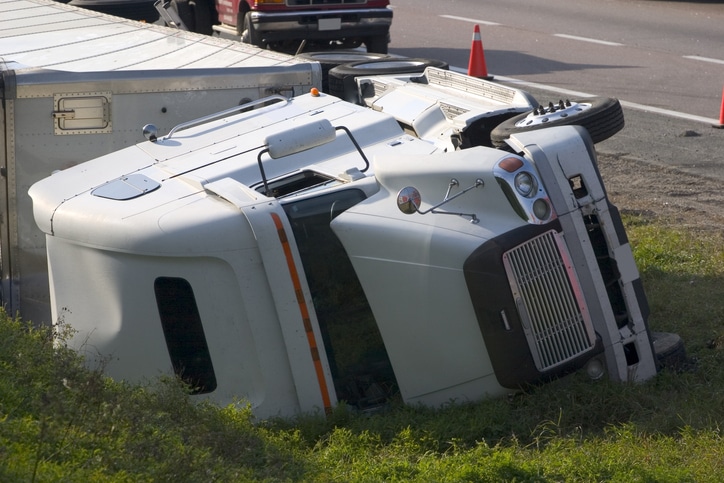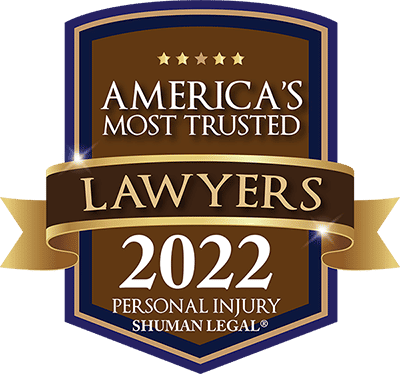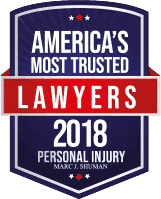What is a Jackknife Truck Accident?
Last updated Monday, August 28th, 2023

Large commercial trucks are intimidating vehicles to cross paths with in any situation. In an accident situation, they are much, much more scary and dangerous. The last thing you want to have to happen is to be involved in a crash with a tractor-trailer that jackknifes.
A semi-truck or big rig is a two-part vehicle. A coupler or fifth wheel connects the cab and trailer together and allows for independent movement between the two parts.
A fully loaded truck can legally weigh up to 80,000 lbs. and can pull a trailer or two up to 53 total feet in length. Because of the size, the potential for injury or even death after a wreck is a very real possibility when an accident happens with a vehicle of that size. Serious injuries, death, or property damages are often the result of the accident.
Truck accident lawsuits can be lengthy and complicated. Trucking companies have a team of legal representatives to argue on their behalf… and you should too.
What is Jackknifing?
Jackknifing is a common term we have all heard but do not necessarily know its meaning. Jackknifing is when the front cab and rear trailer of a semi-truck move out of sync from each other because the driver of the truck is forced to slam on the brakes.
Instead of the trailer riding safely behind the truck cab, it sways to the side and can eventually make the entire truck lose control.
When a trailer, particularly a full trailer, moves like this, the driver is unable to keep control. Think of a semi and trailer at a nearly 90-degree angle to each other… the full rig can be in the shape of a “V.” When this happens, there is no controlling the momentum and the truck jackknifes.
What Causes a Jackknife Truck Accident?
There are several reasons that can contribute to truck jackknifing, including:
- Weather issues – The road isn’t always in optimal condition and can sometimes be wet or slippery. Any loss of traction due to the road conditions is a recipe for disaster with a vehicle as heavy and big as a truck and trailer.
- Operating at a high speed – There is a reason for speed limits and that is simply for safety. When a big rig is moving too fast, it takes much longer for the truck to slow down than a passenger vehicle. The trailer can’t slow down as quickly as the cab and can swing out of control very quickly.
- Following too close – None of us like a tailgater. Often it is just annoying, but when it is a large commercial vehicle, tailgating is a serious safety issue.
- Inexperienced drivers – There is a steep learning curve when a beginner truck driver starts driving. Even with the proper education, much of a driver’s experience comes from real-world situations. This is somewhat offset by requiring the correct licensing but as in any situation, experience is always the best teacher.
- Driver fatigue – Truck drivers are on a schedule and are often required to drive even when they are tired. A tired driver is a safety hazard to all other vehicles on the road.
- Curvy roads and difficult terrain – Going around curves add an extra amount of danger when behind the wheel. Even the best truck drivers can make a mistake and jackknife while going around a curve.
- Improper loading and weight distribution issues – To operate in the safest manner, a truck trailer needs to be loaded so that the weight is somewhat balanced. If one side of the trailer holds most of the weight, or the load has the potential to shift while moving, it is difficult for the driver to operate safely.
Why Does a Truck Jackknife?
As the weight and size of a truck with a trailer can weigh up to 80,000 lbs., it’s no wonder that there is more potential for a serious accident than in a regular car crash.
These trucks are not able to stop as quickly as a passenger vehicle. In fact, if a truck driver does need to slam on his/her brakes, the back trailer simply can’t stop as quickly because it does not have its own brakes. While the trailer keeps moving at the same speed, the cab slows down to avoid a collision.
When a trailer skids sideways but is still connected to the cab, the result is a cab and a trailer that jackknife.
What Should You Do if You’re Involved in a Jackknifing Accident?
After a jackknifing accident occurs, and once you are in a safe place, you need to evaluate your situation. Have you been injured or has your passenger(s) been injured? What is the condition of your vehicle after the crash? Are you unsure what to do now?
Legal guidance from our skilled Chicago truck accident attorneys is available to help you through this difficult process. Look through our website and take advantage of the downloadable information available at your fingertips. We will work through the complicated details and help you decide what the best course of action is for your particular situation. We are committed to making this process easy for you, and affordable at the same time.
How to Avoid a Jackknifing Truck Accident?
Even the most cautious drivers run into problems on occasion. The best thing you can do to avoid being in a jackknifing truck accident is to stay aware of your surroundings. Be careful about putting yourself or your passengers in a position that has even the slightest chance of an accident. Keeping your eyes open and your focus on the road has always been the best way to avoid an accident.


















